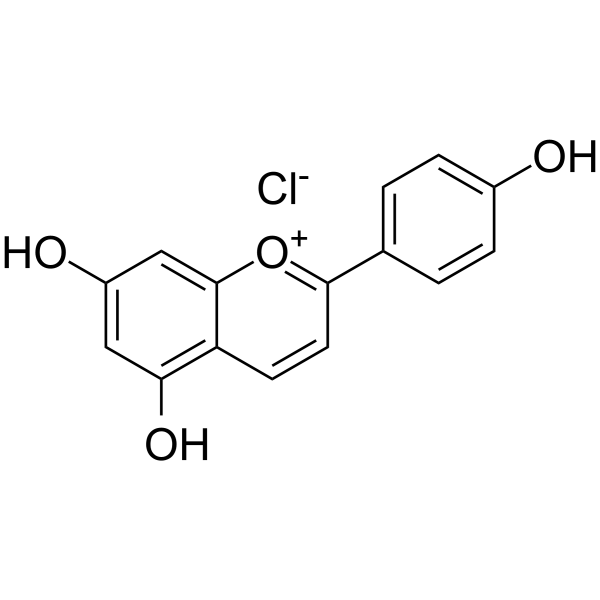1-Benzopyrylium,5,7-dihydroxy-2-(4-hydroxyphenyl)-, chloride (1:1)

1-Benzopyrylium,5,7-dihydroxy-2-(4-hydroxyphenyl)-, chloride (1:1) structure
|
Common Name | 1-Benzopyrylium,5,7-dihydroxy-2-(4-hydroxyphenyl)-, chloride (1:1) | ||
|---|---|---|---|---|
| CAS Number | 1151-98-0 | Molecular Weight | 290.69800 | |
| Density | N/A | Boiling Point | N/A | |
| Molecular Formula | C15H11ClO4 | Melting Point | N/A | |
| MSDS | Chinese USA | Flash Point | N/A | |
|
Novel pyrano and vinylphenol adducts of deoxyanthocyanidins in sorghum sourdough.
J. Agric. Food Chem. 62(47) , 11536-46, (2014) This study determined the fate of deoxyanthocyanidins in sorghum sourdoughs. Sourdoughs prepared from the red sorghum variety Town were fermented with the caffeic acid-decarboxylating strains Lactobacillus plantarum FUA3171 and the decarboxylase negative L. c... |
|
|
Evaluation of the effect of germination on phenolic compounds and antioxidant activities in sorghum varieties.
J. Agric. Food Chem. 53(7) , 2581-8, (2005) The screening of 50 sorghum varieties showed that, on average, germination did not affect the content in total phenolic compounds but decreased the content of proanthocyanidins, 3-deoxyanthocyanidins, and flavan-4-ols. Independent of germination, there are in... |
|
|
Uncommonly high levels of 3-deoxyanthocyanidins and antioxidant capacity in the leaf sheaths of dye sorghum.
J. Agric. Food Chem. 59(4) , 1178-84, (2011) Extracts from leaf sheaths of farmers' varieties of dye sorghum cultivated and used in Benin as a source of biocolorings were analyzed for their anthocyanidin and phenolic contents, as well as their antioxidant capacity. The aim was to identify and quantify t... |
|
|
Quantitative analysis of anticancer 3-deoxyanthocyanidins in infected sorghum seedlings.
J. Agric. Food Chem. 55(2) , 254-9, (2007) 3-Deoxyanthocyanidins are structurally related to the anthocyanin pigments, which are popular as health-promoting phytochemicals. Here, it is demonstrated that the 3-deoxyanthocyanidins are more cytotoxic on human cancer cells than the 3-hydroxylated anthocya... |
|
|
Antioxidant capacity of a 3-deoxyanthocyanidin from soybean.
Phytochemistry 58(7) , 1097-105, (2001) Soybean cotyledons directly exposed to UV-C (190-280 nm) contained a colored pigment in those areas of the epidermis directly exposed to UV-C. Ethanolic extracts from UV-C irradiated cotyledons showed a significant peak at 532 nm at pH=10, but not seen at pH=... |
|
|
New highly stable dimeric 3-deoxyanthocyanidin pigments from sorghum bicolor leaf sheath.
J. Food Sci. 77(5) , C566-72, (2012) The growing interest in natural alternatives to synthetic petroleum-based dyes for food applications necessitates looking at nontraditional sources of natural colors. Certain sorghum varieties accumulate large amounts of poorly characterized pigments in their... |
|
|
Host specificity of Sporisorium reilianum is tightly linked to generation of the phytoalexin luteolinidin by Sorghum bicolor.
Mol. Plant Microbe Interact. 25(9) , 1230-7, (2012) The smut fungus Sporisorium reilianum occurs in two varieties (S. reilianum f. sp. reilianum and S. reilianum f. sp. zeae) that cause head smut disease on sorghum and maize, respectively. Prior to plant infection, compatible haploid sporidia of S. reilianum f... |
|
|
Synthesis of 7-methoxyapigeninidin and its fungicidal activity against Gloeocercospora sorghi.
Biosci. Biotechnol. Biochem. 60(9) , 1495-6, (1996) In the structure of sakuranetin, which was isolated as a phytoalexin from the rice plant, the methoxy group at C-7 has been shown to be important for its high activity. Apigeninidin was isolated as a phytoalexin from sorghum, but it had no methoxy group at C-... |
|
|
Synergistic effect of deoxyanthocyanins from symbiotic fern Azolla spp. on hrmA gene induction in the cyanobacterium Nostoc punctiforme.
Mol. Plant Microbe Interact. 15(9) , 875-82, (2002) The hrmA gene of the N2-fixing cyanobacterium Nostoc punctiforme functions in repressing the formation of transitory motile filaments, termed hormogonia, by plant-associated vegetative filaments. Here, we report that anthocyanins can contribute to induction o... |
|
|
Collagen and muscle stain obtained from Sorghum bicolor.
Scand. J. Clin. Lab. Invest. 66(2) , 161-7, (2006) Crude ethanolic extracts of the leaves of Sorghum bicolor L. Moench were used as stains for tissue sections. The alkaline mixtures did not stain any of the tissues used but the acidic and neutral alcoholic mixtures stained collagen fibres, muscles and red blo... |